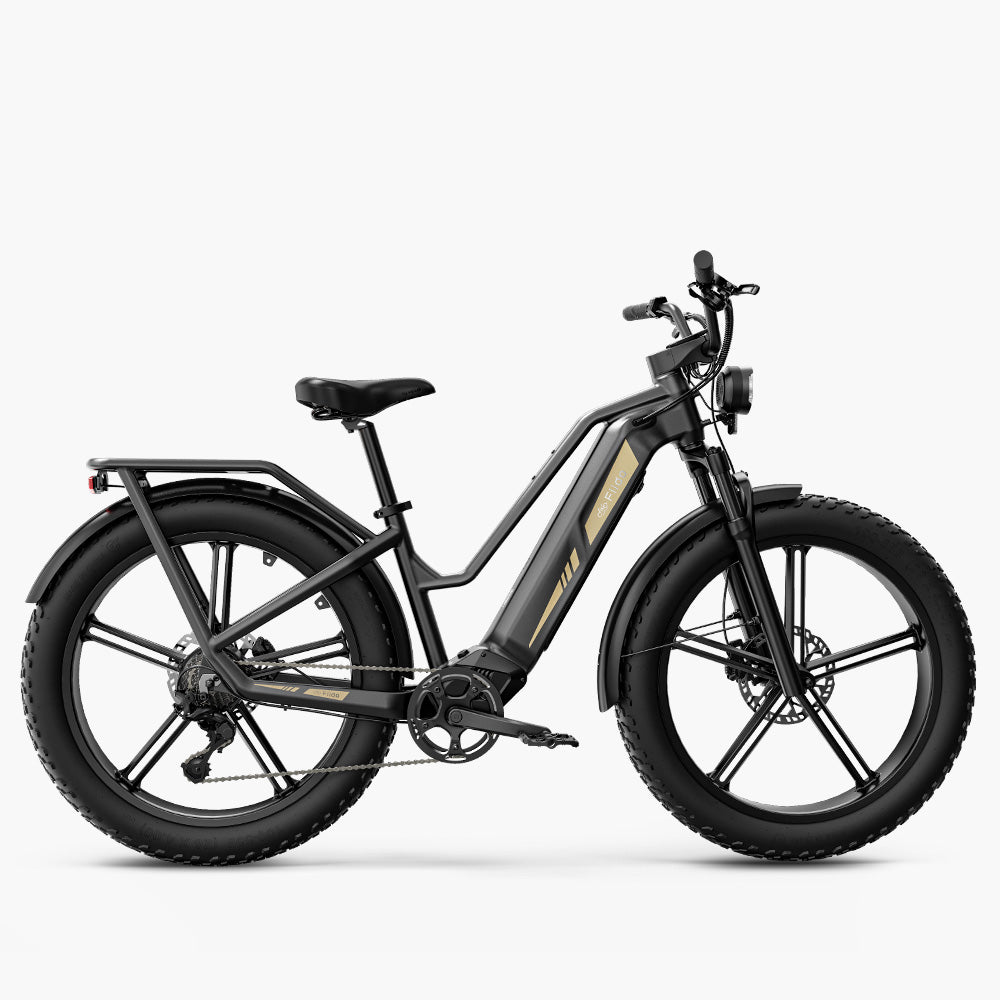
From autumn to winter, most game in the United States—such as white-tailed deer, elk, wild hogs, upland birds, and small game—enter open hunting season. For hunters who frequently move between National Forests, BLM public lands, state-managed Wildlife Management Areas (WMA), or private hunting grounds, the question of “can I ride an e-bike in?” is never simple.
Whether an e-bike can enter hunting areas directly affects legality, safety, wildlife disturbance, and can result in fines or loss of hunting privileges, making understanding the regulations essential.
Hunting areas in the U.S. are typically managed at multiple levels
- Federal agencies (USFS, BLM, NPS, USFWS)
- State wildlife and forest management departments
- Individual districts or forest units
- Private lands and hunting leases
Each of these entities may classify e-bikes as “bicycles,” “motor vehicles,” or in a separate category, resulting in huge regulatory differences.
U.S. E-bike Classification Determines Access
The U.S. generally uses three e-bike classes:
Class 1 (pedal-assist, up to 20 mph)
Considered a bicycle in most states.
Most likely to be allowed on forest roads and trails where bicycles are permitted.
Class 2 (throttle + assist, up to 20 mph)
More restricted; some natural areas prohibit throttle-driven motors.
Class 3 (pedal-assist, up to 28 mph)
Typically allowed only on paved or multi-use roads.
Generally prohibited in hunting areas, National Forests, and mountain trails.
High-power or modified e-bikes (750–1500W+)
Treated as motor vehicles on most public lands and subject to strict management.
Summary: Class 1 is most likely allowed, Class 2 depends on the area, and Class 3 or high-power hunting e-bikes are usually classified as motor vehicles and face the strictest restrictions.
Land Type Determines E-bike Access
A. Federal Lands
1. National Forests (USFS – U.S. Forest Service)
E-bikes are treated as motor vehicles, not bicycles.
Allowed only on motor vehicle roads (as designated on Motor Vehicle Use Maps) or open forest roads.
Most non-motorized trails are off-limits unless explicitly marked otherwise.
Core Rule: USFS treats e-bikes as motor vehicles; non-motorized trails are generally prohibited.
2. BLM Public Lands (Bureau of Land Management)
Rules are slightly more flexible than National Forests.
Some areas allow Class 1 e-bikes on non-motorized trails, but only if specifically designated.
Regulations vary widely by state and BLM district, so consult the local Field Office.
Core Rule: BLM is the federal land most likely to grant exceptions, but local signage must be followed.
3. National Parks (NPS – National Park Service)
Among the strictest federal lands.
E-bikes may only be used on roads officially open to bicycles, usually paved.
Trails are generally off-limits unless explicitly opened by the park.
Core Rule: In national parks, e-bikes = bicycles, but only on officially approved roads.
4. National Wildlife Refuges (USFWS – U.S. Fish & Wildlife Service)
Stricter than National Parks.
Most refuges completely prohibit e-bikes on backcountry trails.
Allowed only on motorized or management roads if the refuge permits vehicles.
B. State Lands
State-managed lands (WMA, state forests, state parks)
Generally the strictest, prioritizing hunting safety and wildlife habitat.
Many WMAs require walk-in only access during hunting season.
Common rules:
E-bikes allowed only on motorized or designated roads.
Non-motorized or multi-use trails are usually prohibited.
Core Rule: Most WMAs do not permit electric hunting bike on small trails, especially during hunting season.
C. Private Hunting Lands
Private land / ranch / hunting lease
Landowner has full authority:
Some private lands welcome e-bikes because:
Lower noise, less disturbance to game
Reduced scent compared to ATVs
Minimal ground damage
Others prohibit e-bikes to:
Protect soft soil
Limit visitor access
Ensure safety
Core Rule: Regardless of legal allowances, private land entry requires explicit landowner permission.
How Hunters Can Confirm E-bike Access
Step 1: Confirm E-bike class
Class 1 is most likely legal.
Class 3 or modified bikes are most likely illegal.
Step 2: Identify land type and consult official regulations
Federal Land
In USFS (National Forests), E-bikes are considered motor vehicles. Check the OHV (Off-Highway Vehicle) section under Recreation on the local National Forest's website for permitted riding routes.
In BLM (Public Lands), some areas allow Class 1 e-bikes on non-motorized trails. Consult the relevant BLM Field Office or official Travel Management page for the latest regulations.
In NPS (National Parks), electric bikes are equivalent to bicycles and are generally restricted to paved roads. Check the Biking page under Plan Your Visit on the specific national park's website.
In USFWS (National Wildlife Refuges), regulations are strictest. Check the Bicycling or Visiting Rules under Activities on the respective refuge's website to see if e-bike use is permitted.
State Lands
Includes WMA, state forests, state parks:Check by searching “[State] + WMA regulations” or visiting the state Department of Natural Resources (DNR / FWP / TPWD / ODFW, etc.) website.
Private Lands
Must get explicit permission from landowner or hunting lease manager.
Legal allowance does not override landowner rules.
Step 3: Review official maps and designated routes
1.USFS MVUM (Motor Vehicle Use Map): the only legally binding map for National Forests. Shows which roads allow motor vehicles. E-bikes are motor vehicles, so this map is mandatory.
2.BLM Travel Management Map: designates Motorized roads, Non-motorized roads, and areas where Class 1 e-bikes are specifically allowed.
3.State WMA regulations
4.Seasonal closures in protected areas
Step 4: Private or leased hunting grounds
Must obtain explicit landowner permission.
Step 5: Check seasonal restrictions
Temporary closures often occur during these times.
1.Fire season
2.Breeding periods
3.Migration season
4.Hunting peak season
FAQ
Q: What is fire season, and why restrict e-bikes?
Fire season usually occurs in summer or dry periods. Heat or sparks from motors, chains, or batteries can pose fire risks, so many forest areas restrict motorized or electric devices during this time.
Q: Why restrict during breeding periods?
Spring and early summer are when wildlife gives birth and raises young. Excessive noise or intrusion can disturb animals and endanger offspring.
Q: Does migration season affect e-bike use?
Yes. Migration routes of elk, deer, or birds may be seasonally closed to reduce disturbances.
Q: Are there special rules during hunting peak season?
Some areas restrict vehicle access or require specific entry points for safety. Check state hunting calendars carefully.

Our Hunting E-bike
Fiido Titan is designed for rugged U.S. forest terrain and long-distance hunting:
26×4.0-inch fat off-road tires for traction in mud, sand, or snow
60mm front suspension reduces bumps and minimizes wildlife disturbance
200kg payload (rider 120kg + rear rack 80kg) accommodates gear, packs, or small game
115km range (single battery) / 347km range (three-battery setup) for long or remote trips
Four-piston hydraulic brakes with power-cut protection
70 N·m torque for climbing, ditches, and forest obstacles
Fiido Titan Robust Cargo Electric Bike
A powerhouse with a 248-mile range and 4-piston brakes, ideal for hunting and fishing trips.
Reminder: Prices are subject to the product detail page ,some earlier card details may have been updated.

















